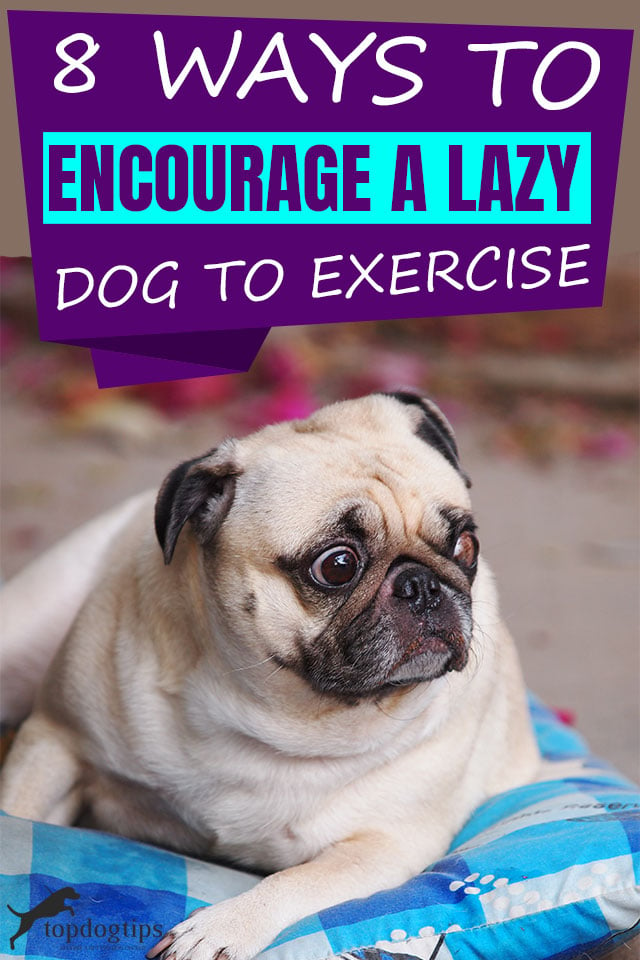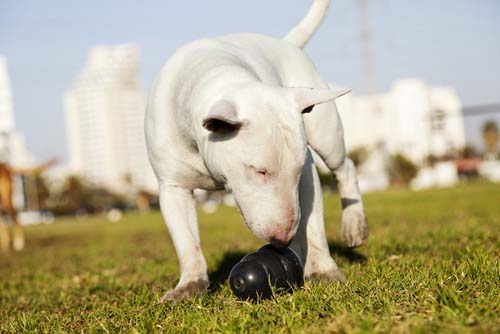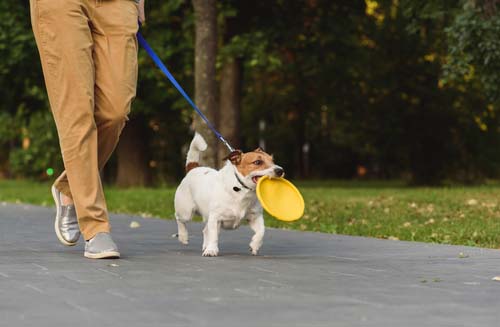Generally, dogs need anywhere from 30 minutes to two hours of daily exercise. Some large breeds, athletic/active breeds and working dogs will usually need more (at least two hours of vigorous exercise, while small dogs and brachycephalic short-nose breeds will require less.
Table of Contents
1. Start With Regular Walks
The best way to encourage a lazy dog is by starting slowly, with more regular walks. Begin with a stroll around the block and slowly increase the speed and length of the walk.
Never push your pup to do more than they are comfortable with. Like people, dogs need to build their endurance, and if your dog has been lazy and sedentary for a long time, even a slightly longer walk can be strenuous to them. Extra small breeds and senior dogs may also have limitations, as will those that suffer from underlying health issues like joint or heart problems.
Keep your dog motivated by changing up the location or direction of the walk each day.
2. Food-Dispensing Toys
Toys that get your dog moving are very convenient for this. Dog toys like KONG are made from tough rubber with a hole in one end and are available in a variety of sizes. To teach your dog how to use a Kong, start by inserting small pieces of kibble or dog treats that will easily fall out of the toy with very little effort.
Once your dog knows how to play with a KONG toy, make it more difficult by using food that isn’t easily extracted. These include:
- Bigger chunks of fresh fruit or vegetables
- Peanut butter
- Cubes of cheese
- Canned dog food
- Mashed potatoes
- Mashed or chunked banana
Always thoroughly wash and rinse the KONG toy after using mushy or fresh food to prevent mold and bacteria growth.
3. Treat Hunt Game
Games like hide-and-seek and treat hunt will motivate your lazy dog to move. While your dog is in their crate or outside, hide a food-loaded KONG toy, some other toy, kibble or dog treats somewhere in your home. Release the dog and say “kibble hunt.”
Until your pet knows the game, hide the kibble in easy to find spots. As your canine progresses, choose more difficult hiding places to increase the challenge and exercise level. Done effectively, this game can promote digging, climbing, ducking, and running.
4. Doggy Playmates and Play Dates
Get your dog involved with another canine for a play date either by meeting at a dog park or by a simple encounter during a walk. Most dogs are responsive to one another by sniffing, circling, and marking their territory.
If the dogs are compatible, they will naturally want to amp up the exercise with light play or chasing each other. If your dog is very lazy or antisocial, get involved in the play with a game of fetch and reward your pet with treats for interacting with the other dog.
Your area may also have local dog groups based on breed or age that you can ask to join.
5. Play More Games
Get your dog involved in a one-on-one game with yourself or a family member. Tug-of-war and fetch are great for small indoor spaces (for outdoors, you can use a toy launcher). Use a long hall or rec room to throw a ball and any space for tug.
There's many games to play indoors, but our dogs love hide-and-seek the most. With your dog in the “sit and stay” position, hide in a different room. Call your pup's name and wait until he locates you. Reward with a treat and praise. Repeat the process by hiding in a different spot.
If your dog becomes lazy or bored of the game, take them to a new location like the backyard or your local park, or switch to something else.
6. Dog Training Classes
Surveys show that 46.7% of pet parents attend classes with their dogs, while 45.5% train their dogs themselves. Obedience training is a way to get your dog active and teach them the basic commands, whether you do it in a “classroom setting” or yourself from a book or YouTube video.
Once your dog has mastered basic obedience, there are advanced tricks that other classes can help you build upon the basics. Some dog training centers also offer teaching a dog to play popular dog sports such as flyball or obstacle course/agility training.
Training classes are most effective when the pet parent continues the training methods at home. This consistent work reinforces the command and will promote healthy activity in your lazy dog.
7. DIY Obstacle Course
Agility training doesn't have to take place in a class. Building a dog obstacle course at home can be as simple as setting up furniture for your pet to run around, climb, jump over, or shimmy under. Use pillows, low coffee tables, broomsticks, boxes, and other household items and furnishings to encourage full-body movement.
For more room to maneuver and run around, build it in your backyard. Outdoor obstacle courses for dogs can consist not only from the agility-specific equipment you buy but also trees in the yard, plastic traffic cones, picnic tables, outdoor tools such as racks, and plastic or wooden lounging chairs.
8. Hire a Dog Walker
If you don’t have time each day to exercise your dog, then hire a professional dog walker or pet sitter to step in. Use a professional agency service, a pet sitting app, a friend, a neighbor or a family member when you are away to get your lazy dog off the bed and outside walking, hiking or playing with his doggy buddies.
Conclusion
Studies have shown that dogs can determine a human’s mood by our vocalizations and facial expressions. In other words, if we are unhappy, bored, or too lazy to exercise our dogs, then perhaps they are picking up on that and reacting the same.
When using any of the above techniques for encouraging a lazy dog to exercise, remember to have fun. Use an enthusiastic tone of voice, encourage your dog with treats or a KONG toy, and change up the style and location of the exercise session.
If you need the motivation to get active with your canine companion, join an obedience class, or build/purchase a DIY obstacle course. If you simply don’t have the time, hire a professional dog walker, or enlist the help of a dog-loving friend or family member.
READ NEXT: 10 Ways to Relieve Boredom in Dogs
Want To Share This?


















